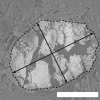Microcalcification crystallography as a potential marker of DCIS recurrence
- PMID: 37291276
- PMCID: PMC10250538
- DOI: 10.1038/s41598-023-33547-8
Microcalcification crystallography as a potential marker of DCIS recurrence
Abstract
Ductal carcinoma in-situ (DCIS) accounts for 20-25% of all new breast cancer diagnoses. DCIS has an uncertain risk of progression to invasive breast cancer and a lack of predictive biomarkers may result in relatively high levels (~ 75%) of overtreatment. To identify unique prognostic biomarkers of invasive progression, crystallographic and chemical features of DCIS microcalcifications have been explored. Samples from patients with at least 5-years of follow up and no known recurrence (174 calcifications in 67 patients) or ipsilateral invasive breast cancer recurrence (179 microcalcifications in 57 patients) were studied. Significant differences were noted between the two groups including whitlockite relative mass, hydroxyapatite and whitlockite crystal maturity and, elementally, sodium to calcium ion ratio. A preliminary predictive model for DCIS to invasive cancer progression was developed from these parameters with an AUC of 0.797. These results provide insights into the differing DCIS tissue microenvironments, and how these impact microcalcification formation.
© 2023. The Author(s).
Conflict of interest statement
The authors declare no competing interests.
Figures






References
-
- Cancer Research UK. In situ breast carcinoma incidence statistics. https://www.cancerresearchuk.org/health-professional/cancer-statistics/s... (2018).
-
- American Cancer Society. Breast Cancer Facts & Figures 2019–2020. https://www.cancer.org/content/dam/cancer-org/research/cancer-facts-and-... (2020).
-
- Netherlands Comprehensive Cancer Organisation. Netherlands Comprehensive Cancer Organisation. http://www.cijfersoverkanker.nl.
Publication types
MeSH terms
Substances
Grants and funding
LinkOut - more resources
Full Text Sources
Medical

